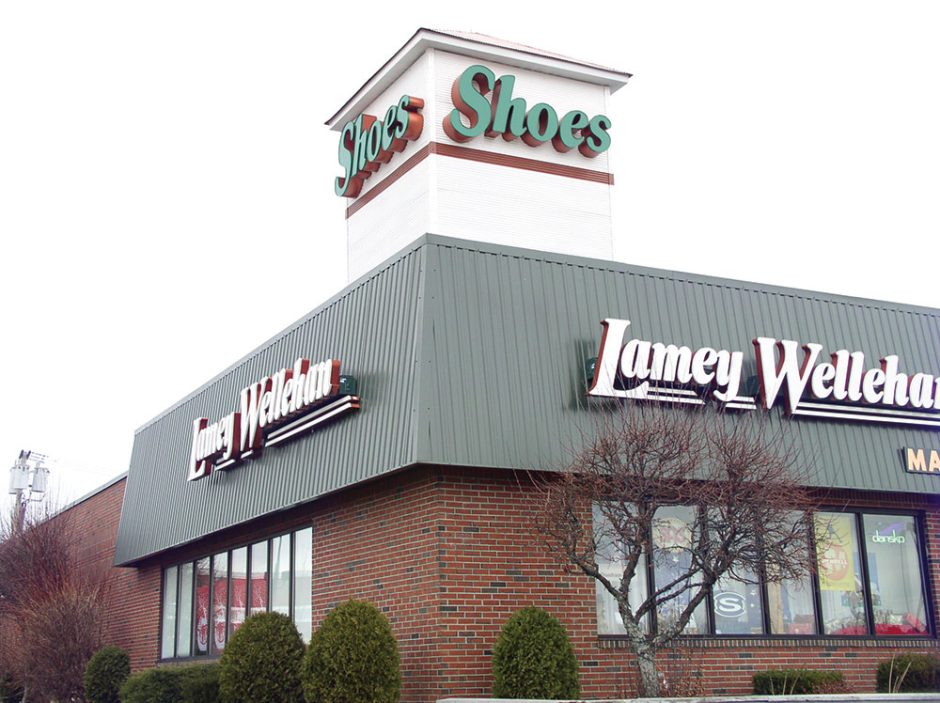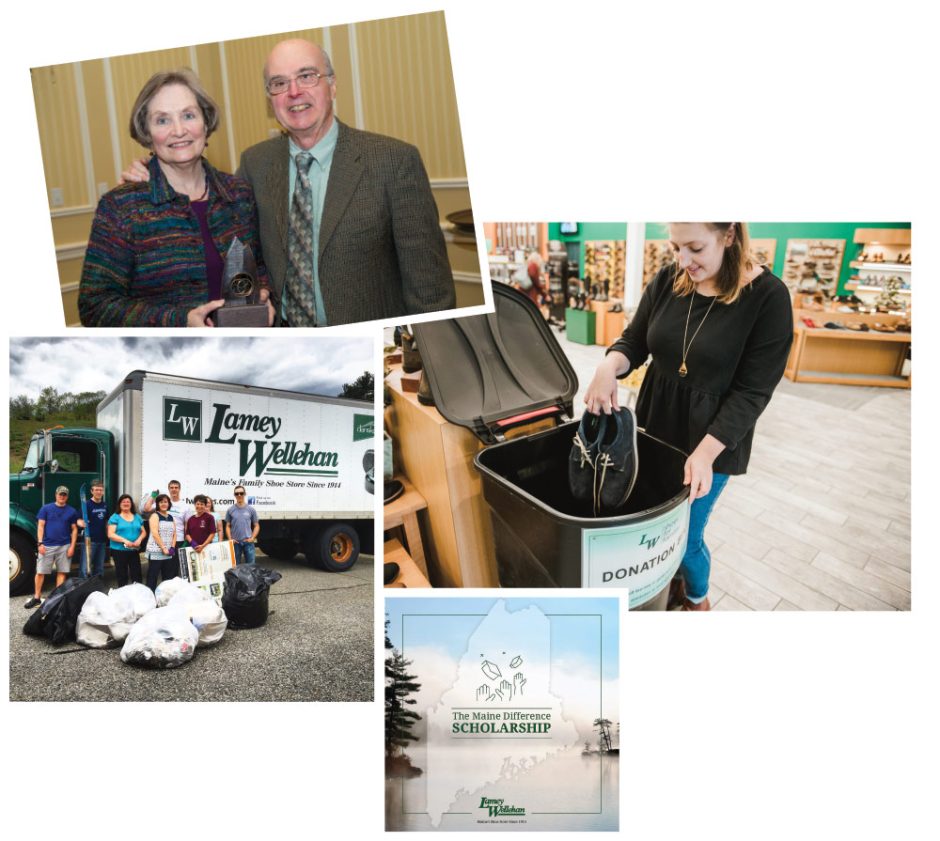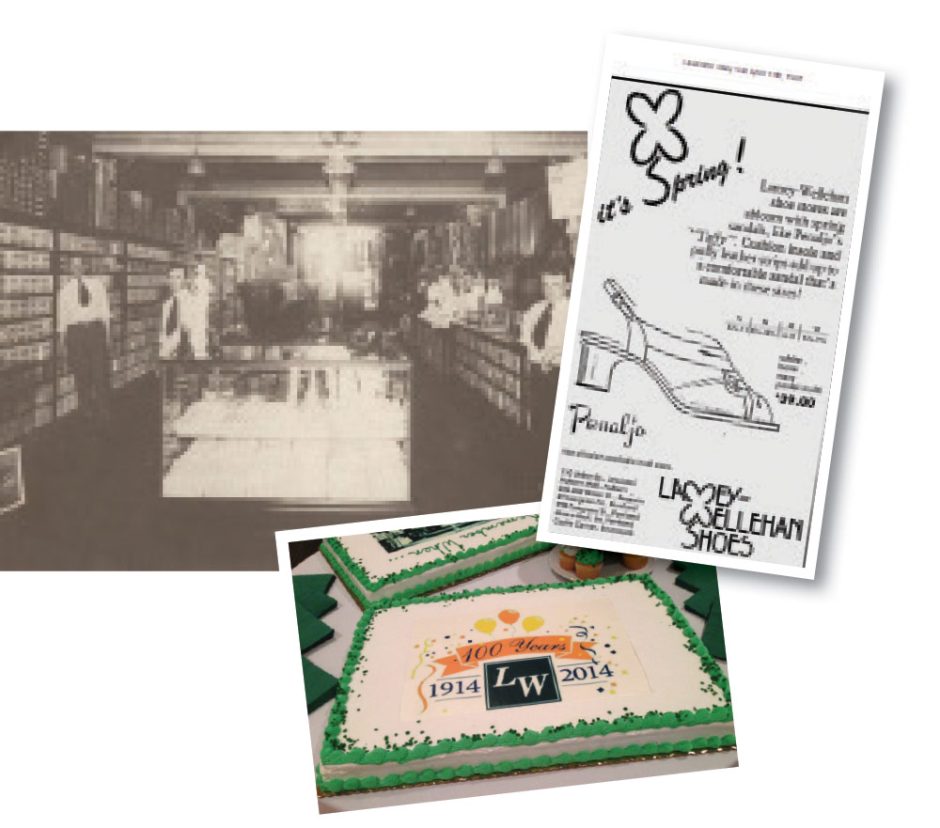
If you grew up in Maine, you probably know the family shoe chain Lamey Wellehan. I got my back-to-school penny loafers there every year as a kid in the ’90s. It was as sure a sign of fall as the leaves beginning to turn.
 Lamey Wellehan is an institution—one of those “Maine names,” like Moxie, Oakhurst, Jolly John. (Mainers know what I mean). So when I moved home to the Pine Tree State a few years ago, after a decade or so in the New York Metro area, and I needed to outfit my three kids in proper winter boots, I headed to the nearby Lamey Wellehan in Scarborough. The large, bustling store greeted us and got right to work. Everyone’s feet were expertly measured, which was a refreshing treat after a pandemic of shopping mostly online. We left with three pairs of Bogs boots that had enough wiggle room to accommodate wool socks and would last more than a season. I’d expected our shopping excursion to feel nostalgic, but it also felt much more efficient—not to mention eco-friendly—than having six to nine boxes shipped to our home and then returning some (a back-and-forth hassle we’ve dealt with multiple times).
Lamey Wellehan is an institution—one of those “Maine names,” like Moxie, Oakhurst, Jolly John. (Mainers know what I mean). So when I moved home to the Pine Tree State a few years ago, after a decade or so in the New York Metro area, and I needed to outfit my three kids in proper winter boots, I headed to the nearby Lamey Wellehan in Scarborough. The large, bustling store greeted us and got right to work. Everyone’s feet were expertly measured, which was a refreshing treat after a pandemic of shopping mostly online. We left with three pairs of Bogs boots that had enough wiggle room to accommodate wool socks and would last more than a season. I’d expected our shopping excursion to feel nostalgic, but it also felt much more efficient—not to mention eco-friendly—than having six to nine boxes shipped to our home and then returning some (a back-and-forth hassle we’ve dealt with multiple times).
Lamey Wellehan is shoe shopping the way it used to be: a genuine sit-and-fit experience. Some things never get old as the now six-store chain, based in Auburn, proves by celebrating its 110th anniversary this year. The multi-generational family business has survived two world wars, the Great Depression, Great Recession, big box stores, Retail Apocalypse, personal tragedies, the rise of online shopping, the pandemic, and everything else. Today, Lamey Wellehan’s six locations, dotted along the state’s coastal corridor, do about $14 million in annual sales. Stores have opened, moved, and closed over the decades, but the chain has hovered between four and seven locations. The past four years was no picnic. But like the challenges it has overcome before, the retailer found a way. Of late, business is healthy. Yet Lamey Wellehan’s story of longevity isn’t really one about a business that’s changed with the times, rather it’s much more about how it has managed to stay true to itself and to its customers. The more the world changes, the more Lamey Wellehan stays the same. That’s its secret sauce.
“For us, it’s all about relationships—with our guests, our associates, our vendors, and our community,” says Chris Stanley, president, who joined as a department manager in 1988 and named president in early 2022. “That’s what we’re always striving for, and when you go into our stores, you feel it.”

Stanley’s use of the word guest is intentional, as is associates versus employees. “You’re always a guest before you’re a customer,” read a sign that founders Charlie Lamey and Dan Wellehan hung over the door of their first store, in Lewiston, before its grand opening on St. Patrick’s Day 1914. (Guests were given shamrocks). Treating customers like friends and employees like family have been core Lamey Wellehan values from the get-go, and the store’s tight connection with its communities has generated tremendous loyalty. Many of these stores have served generations of families. They’ve fitted customers with their first pairs, watched them grow up and head off to college, and return to raise families. That level of connection isn’t transactional. Customers have plenty of alternatives to buy shoes, but they choose to shop here. The chain’s consistency, expert customer service, quality selection, and extensive community outreach efforts matter. Lamey Wellehan plays the long game.
“Lamey Wellehan is a very conservative, Yankee-values operation,” says Barry Ryan, a Blundstone rep who’s worked with the retailer for 35 years involving various brands. “Service and fit are the key ingredients to their success.”
Allison Frazier, a rep for Oboz, describes Lamey Wellehan as a unique, premium class of footwear retailer that has stood the test of time. “They are the benchmark for success,” she says. “Their model is shockingly simple: high-quality customer engagement, education, attentiveness to the fitting process, and care and loyalty to the communities they’re in.” Frazier adds, “You can feel these elements from every staff member in every store, and that consistency of experience is testament to their longevity.”
Many say the chain’s people-first approach stands out moreso as other stores cut back greatly on service. “I recently stopped into a boot store by the Maine Mall and the salesperson wouldn’t even come out from behind the desk,” says Jeff Church, who started working with Lamey Wellehan as its Avia rep in the ’80s and now reps Frye and several other brands. “You walk into a Lamey Wellehan and you get service, service, service!” That focus on building strong relationships applies to the business side, too. “They treat everyone with respect, from customers to the people they work with,” Church says. “In all these years, I’ve never had Lamey Wellehan be late paying a bill, ever.”
Indeed, Lamey Wellehan owns a solid reputation for being one of the industry’s good guys. “They’ve maintained their heritage but are also very modern and progressive in terms of their employee training/retention, community outreach, and environmental impact,” says Jeff Martin, a Dansko rep, who began working with the retailer during his Timberland rep days in 2011. “They’re an extremely well-run company, and they have very bright people. It’s clear they’re passionate, engaged, and enthusiastic about their company, their brands, and their careers.”
By the Numbers

Lamey Wellehan may come across as old school in its format but there is nothing archaic about its approach to business. It’s a buttoned-up operation. The chain stocks around 200 brands and carries 100,000 pairs in inventory. The staff numbers around 70. Any and all data is collected, analyzed, and acted upon.
“Numbers are important, and we have to watch our KPIs and metrics,” Stanley says. “We need to know when to mark down, when to get things in. Converting rates, multi rates, and average tickets helps us to survive tough times. If you watch the numbers, you’ll get out of a tough situation, and we’ve been able to get out of a lot.”
Other key metrics include seeing what website visitors search for and tracking which categories associates are selling strongest. “We share as much data among the staff as we can,” Stanley notes. That includes its Daily Dashboard email, which lays out company-wide stats from the previous day in a digestible format complete with comics. In addition to by store stats like total sales, average sale per slip, total number of slips, and guest traffic, it ranks top-selling associates and brands. One recent edition cited a big win: “Thursday’s top sale came from Crystal in R04. She had a great seven-item, $686 sale! It included not one, not two, but four pairs of Aetrex memory foam insoles. It also had two Brooks running shoes and a Timberland work boot.”
Lamey Wellehan leans heavily on face-to-face data collection, as well. It knows what guests want because associates find out the old-fashioned way: by chatting with them. When it comes to marketing, it leans on word-of-mouth and a strong community presence fostered by charitable initiatives. Current examples include The Maine Difference, an annual scholarship awarded to three students studying at Maine colleges with a focus on the state’s economy or ecology. The program tripled in size when the company, in 2015, began putting the $8,000 it saved yearly on plastic bags toward the program. Also, since 2010, its Shoes for Families program has collected customers’ gently worn footwear and redistributed tens of thousands of pairs to local organizations serving people in need.
Goodwill is ingrained in Lamey Wellenan’s culture. Jim Wellehan, who became president in 1976, and his wife Kathy, have long been the torch bearers. They view it as key to the chain’s success. In 2014, Lamey Wellehan was honored with a Family Business Award for “treating employees like family” and having a “customer-first” mentality. It was also recognized for its sustainability efforts, which include a company-wide recycling program, introduced in the ’90s, that recycles more than 90 percent of material that enters its stores. Since the early 2000s, the new stores have been outfitted with recycled-plastic carpeting, enhanced insulation, and rooftop solar panels. In 2014, Jim and Kathy Wellehan received the National Resource Council of Maine’s Conservation Leadership Lifetime Achievement Award. In 2020, Lamey Wellehan achieved its goal of reducing its carbon emissions by 50 percent.
The goodwill reflects inward, as well. By retail standards, there isn’t much turnover at Lamey Wellehan. Stanley credits it being a “comfortable” place to work. “We enable associates to be free thinkers, and every store is slightly different,” he says. “We don’t have a lot of corporate rules and procedures; just standards we try to meet. Being trusted to handle things the way you want is really refreshing.” The company also operates a unique bonus/commission system that allows associates to earn more during periods of increased productivity. Wellehan has also long been a proponent of increasing minimum wage. In 2014, he appeared in a video by the nonprofit Organizing for Action regarding the issue.
Another way Lamey Wellehan maintains a content and cohesive team starts at the hiring process. Managers focus on attitude. Skills can be taught on the job. Training is centered around three Fs: feet, footwear, and fitting. “We have our own educational program covering biomechanics, shoe construction, and proper fitting, which gives our associates a little more street cred—they earn the respect of guests who come in,” Stanley explains. Associates are also trained on its foot scanners that takes the shopping experience to another level.
Looking Ahead

Might there be more stores on the horizon? It’s finally feeling at least possible. “Things have been tricky since 2020,” Stanley says. “First it was Covid, the next year it was supply chain, then finding staff, then inflation. Hopefully, we’re getting back to the norm.” But there’s no rush. “I always joke that we’ve been around 110 years and have six stores, so at this rate of growth, in the year 2097, we should be pretty close to 20,” he says.
In the meantime, business keeps chugging along. Staples like New Balance, Johnston & Murphy, Birkenstock, and Dansko form a strong base, as do foot-health products by Aetrex and Superfeet as well as work boots by Carolina, Skechers, and Keen, among others. “We have accounts with many businesses in the area who send their employees to us, and we’ll get them properly fitted into the right shoes for the job,” Stanley says, adding that the recent spike in sneakers has given the chain another revenue stream boost via brands like Hoka, On, and Brooks.
Stanley is optimistic about Lamey Wellehan’s future. He’s investing in new categories and brands to test, plus upgrading some stores. “We feel like it’s a good time to be bullish, because retail in general hasn’t been bullish for years,” he says. “It feels like time to get back to being proud of who we are and making things grow.” Stanley believes the chain has the support of the communities it serves to make investments in the future. “We’re part of our communities, part of something bigger, and are always trying our best to uphold our side of that bargain,” he says.
Lamey Wellehan’s long-running success boils down to old-fashioned Maine scrappiness and fortitude—and some luck perhaps, too. (The original owners did dole out shamrocks that first day.) Whatever the reasons, the chain is as vibrant as ever. Same goes for Wellehan, who at age 86 is purportedly retired, but still pops in regularly to check on things. “Jim likes to compare Lamey Wellehan to a bumblebee,” Stanley shares, noting that scientists have said the insects shouldn’t be able to fly. “It’s the same with Lamey Wellehan. We carry almost 200 brands and 100,000 units spread across our six stores, stretching ourselves in many directions. That’s a little heavy, but 110 years later, we’re still flying.”



